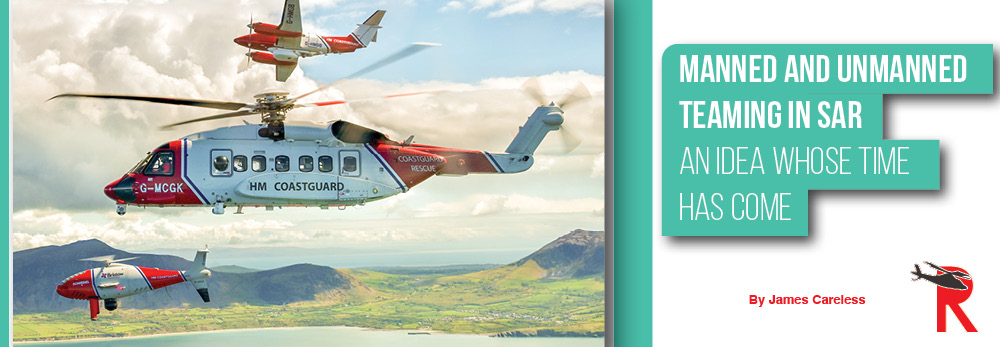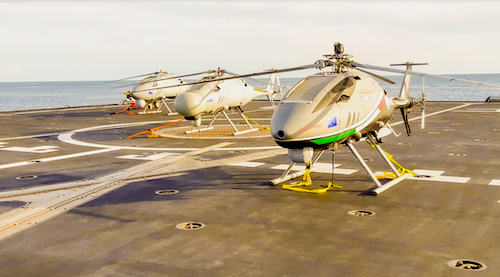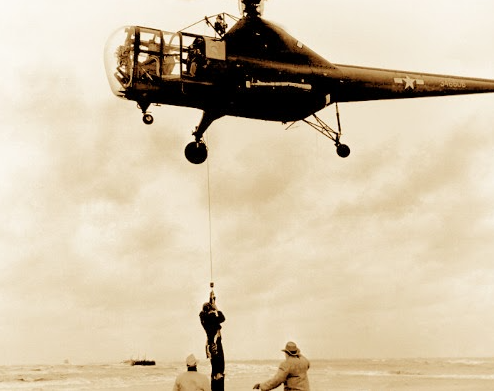|
Oct
18
2021
|
|
Posted 4 years 69 days ago ago by Admin
|
|

The teaming of manned search and rescue (SAR) helicopters with unmanned aerial systems (AKA drones) is an idea whose time has come. Remotely controlled drones can be immediately dispatched to search for victims and identify landing zone hazards while a SAR helicopter is preparing to fly. Once aloft, the SAR helicopter crew can use the drone’s data collected to reduce their flight time to the victims.
“Unmanned systems can reduce exposures and risks to SAR personnel as part of their operations,” said Johnny T. Doo, group leader for NASA Transformative Vertical Flight Working Group-4: Public Services and also president of International Vehicle Research Inc. “It's a combination that is becoming more and more popular because there are tasks in SAR that are not human-friendly,” added Juan Plaza, a UAV/general aviation consultant. “Drones can search for victims at night during fires and other environmental conditions that pose dangers to manned aircraft.”
The big question for SAR operators is just how far the teaming concept can go. Given advances in artificial intelligence (AI), autonomous (self-flying) drones, and the growing computing power onboard manned helicopters, it seems possible that tomorrow’s SAR helicopters could fly out accompanied by swarms of self-coordinating surveillance drones and that these drones could do more than just relay visual data back to their human operators.

New Idea That Works
The teaming of drones and helicopters is still a new idea for many SAR operators. Still, it is one that is being nurtured by ground-based SAR units. “Traditional airborne public safety units that are conducting SAR operations are typically supporting ground-based units,” said Terry Miyauchi, Bell’s parapublic customer solutions manager. “These units are already starting to utilize small UAS directly as they coordinate their operations with air-based SAR units.”
In Canada, the Canadian Armed Forces teamed one of their Israel Aircraft Industries Heron drones with a fixed-wing aircraft piloted by the Civil Air Search and Rescue Association (CASARA) in a concept-proving SAR exercise. This was done by using a simulated aircraft wreck on the ground in Suffield, Alberta, with actors on site serving as ‘victims.’
“In this exercise, the Heron drone would spot the target using a grid pattern, then we’d fly in and drop a small aerial rescue kit to the people on the ground,” said Frank Schuurmans, pilot and president of CASARA-Saskatchewan. “This was our first exposure to teaming and it worked well. As drone technology improves, I can see teaming being a big part of our future.”
More Than Just Surveillance
In the current teaming model, ground-controlled drones worked with SAR helicopters to spot and retrieve victims. The two operate separately, with information being shared between ground-based drone controllers and helicopter crews in flight.
Sikorsky’s SuperSearch™ is being developed and designed to incorporate MATRIX technology for SAR operations. According to Sikorsky, SuperSearch uses an advanced algorithm to search within a designated area block for an object such as a life raft or a boat. The company’s simulations have shown that SuperSearch can find such objects up to 30 percent faster than by using a traditional search pattern.
Igor Cherepinsky is director of Sikorsky Innovations, the section of Sikorsky that develops next-generation technology such as the Sikorsky MATRIX autonomous flight control system. As far as Cherepinsky is concerned, SuperSearch is only the beginning of what MATRIX can provide for SAR operations, especially those using teamed helicopters and drones. He foresees a time when a Sikorsky SAR helicopter using MATRIX will fly in tandem with a series of autonomous surveillance drones. In this model, the drones scour the search area, sending their data back to the helicopter’s computers that automatically sift through the sightings and alert the pilots to the most likely matches.
Since the helicopter’s flight systems are being managed by MATRIX, the pilots can spare the time to critically analyse the pre-sifted drone data. This allows them to make better-informed decisions quicker, resulting in faster rescues and more lives saved. “We want to get away from pilots having to focus on managing the cyclic and collective, and let them be able to think more about the actual rescue,” Cherepinsky told Rotorcraft Pro. “We also want to reduce the workload of interfacing with a massive suite of sensors, by having only the most useful of contacts presented to them in an integrated fashion.”
Advanced teaming SAR response is also on the mind of Leonardo Helicopters, which bills itself as the only OEM that develops and manufactures SAR helicopters and a full range of drones. “Our company has successfully demonstrated manned/unmanned teaming technologies and capabilities to enhance SAR operations during different operational exercises,” said Roberto Pretolani, the company’s Rotary Unmanned Aerial Vehicle (RUAV) segment marketing manager. These exercises include the European Defence Agency’s (EDA) Italian Blade (2015), the Royal Navy’s Unmanned Warrior (2016), and the EDA’s OCEAN2020 (2019).
“Performing SAR operations with a mix of manned and unmanned platforms can effectively increase search persistence and area coverage while limiting the use of manned aircraft only when strictly necessary,” said Pretolani. “As an example, Leonardo’s AWHero 200kg.-class rotary unmanned system can provide up to six hours all-weather search capability while equipped with a SAR sensor suite including electro-optical/infrared camera, automatic identification sensor, and maritime search radar. An AWHero system composed of two air vehicles can be deployed in rotation to further extend search persistence up to 24 hours.”

During its mission, AWHero can transfer collected information (including real-time videos) to SAR coordination centers on the ground. “AWHero can share the same set of information with a manned platform to be directly displayed on Leonardo helicopters fully digital cockpit HMI in order to maximize aircrew situational awareness prior to insertion in critical rescue tasks,” Pretolani said.
Airbus Helicopters is similarly interested in teamed SAR missions. Its UAS is theVSR700, an unmanned VTOL based on the manned Cabri G2 light helicopter designed and built by French SME Guimbal. “The VSR700 has capabilities and features that could be ideal for SAR missions, mainly its endurance, payload, autonomy, and handling qualities,” said Nicolas Delmas, head of Airbus Helicopters’ VSR700 program. “Thanks to the dynamic system developed on the Cabri G2, the VSR700 will also be able to fly in difficult weather conditions as often encountered during SAR missions.”
According to Delmas, the VSR700 sensors currently being tested for the French Navy include a radar and an electro-optical turret, both could be used for SAR missions to detect and identify people and vessels in trouble. “If a customer requires it, Airbus Helicopters could work on the integration of specific SAR payloads like a raft or a survival kit that could be dropped from the VSR700,” he said.

In April 2018, Airbus Helicopters tested the ‘Manned/Unmanned Teaming (MUM-T)’ capabilities of an H145 helicopter and a VTOL UAS working together directly. “The test demonstrated that the manned platform could exercise full control of the UAS including its takeoff and landing,” said Delmas. “In SAR missions, a VSR700 or multiple VSR700s could be placed under the control of a manned helicopter to perform search tasks. This team would then be able to cover greater areas than a single helicopter would. It would also be less expensive to operate than multiple manned helicopters.”
Bell also has a horse in the teaming race, namely the company’s Autonomous Pod Transport (APT) unit. This is a unique four-engine equipped frame that lifts cargo within a central pod vertically from the ground, adopts a horizontal flight profile to get from Point A to Point B, and then resumes a VTOL stance for landing.
Bell’s Terry Miyauchi can foresee the APT being used to rapidly deploy critically important supplies to victims during SAR missions, in addition to providing advance spotting for manned helicopters heading to the accident scene. “At the same time, Bell largely sees the primary response aircraft for today’s SAR mission as manned systems,” he said. “This is definitely seen because of the vast deltas between manned and unmanned systems in payload ability, speed, range, and endurance beyond line of sight and extraction ability.”
Enter the eVTOLs
There’s a third player that can be added to the helicopter/drone teaming mix, and that is eVTOLs – electric VTOL aircraft capable of carrying one or more medics to an accident scene. As envisioned by Carl Dietrich, president and founder of the EMS eVTOL startup Jump Aero, these eVTOLs could form a “quick response medical bridge” distinct from drones and helicopters.

“EMS eVTOLs could be based at SAR posts, fire stations, and other first responder agencies,” Dietrich explained. “When a 911 dispatcher gets the call that requires advanced life support, the closest EMS eVTOL could be sent to the scene immediately. The EMS medic could treat them promptly and improve their condition while waiting for the ambulance or air ambulance helicopter to arrive.” Due to the eVTOL’s ability to quickly switch on and fly electrically, compared to the start-up time for a gas-powered helicopter, Dietrich estimates that the human medic response time to such incidents could be cut in half.
The Next Step in SAR
According to the This Day in Aviation website, 29 November 1945 marked the first civilian helicopter rescue in history. A Sikorsky YR-5A equipped with an external rescue hoist was flown during a storm to Texaco Barge No. 397. It was breaking apart on Penfield Reef (about one mile offshore from Fairfield, Connecticut), putting the crew of Captain Joseph Pawlik and Steven Penninger in mortal danger.

While Sikorsky Chief Test Pilot Dimitry D. (“Jimmy”) Viner kept the YR-5A hovering above, U.S. Army Air Forces Captain Jackson E. Beighle “raised the harness with Penninger to the cabin but could not pull him inside,” states the web site. “Penninger hung on to Beighle while Viner flew the helicopter to the beach.”
Captain Pawlik was then rescued: “When Beighle attempted to raise the hoist it jammed, leaving Pawlik suspended 30 feet (9 meters) below the helicopter. Viner again returned to the shore and carefully lowered Pawlik to the sand.”
This rescue transformed SAR in 1945. Teaming is about to transform it again. The coming combination of helicopters, drones, and eVTOLs will exponentially expand the power of SAR operators to find, treat, and remove victims in speed and safety—and this future will arrive sooner than we think.